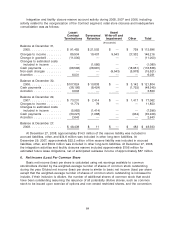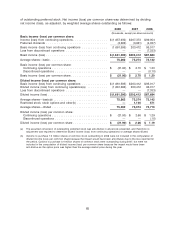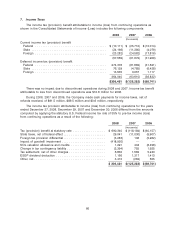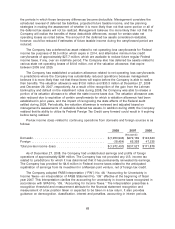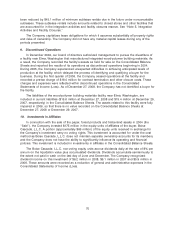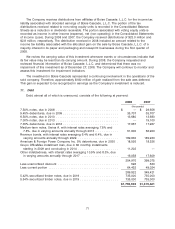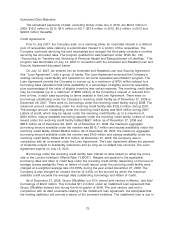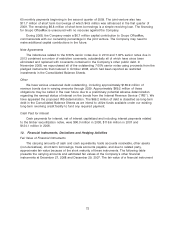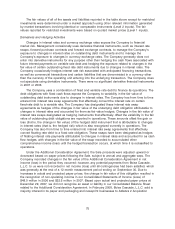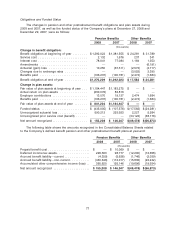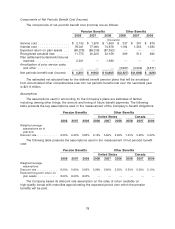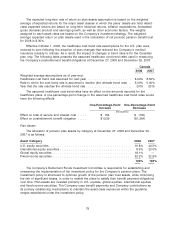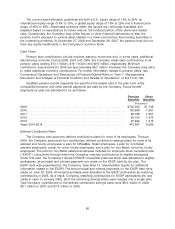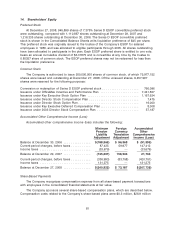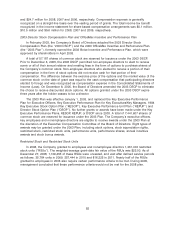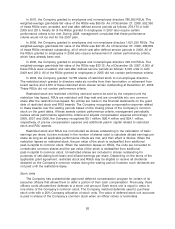OfficeMax 2008 Annual Report Download - page 78
Download and view the complete annual report
Please find page 78 of the 2008 OfficeMax annual report below. You can navigate through the pages in the report by either clicking on the pages listed below, or by using the keyword search tool below to find specific information within the annual report.
is the amount at which the instrument could be exchanged in a current transaction between willing
parties.
2008 2007
Carrying amount Fair value Carrying amount Fair value
(thousands)
Financial assets:
Timber notes receivable
Wachovia— ........... $817.5 $801.9 $817.5 $881.8
Lehman— ............ 81.8 81.8 817.5 881.8
Restricted investments ....... 2.1 2.1 22.4 21.8
Financial liabilities:
Debt .................... $355.0 $236.7 $398.4 $396.6
Securitization notes payable
Wachovia— ........... $735.0 $736.8 $735.0 $790.9
Lehman— ............ 735.0 81.8 735.0 790.9
The carrying amounts shown in the table are included in the Consolidated Balance Sheets
under the indicated captions. The following methods and assumptions were used to estimate the
fair value of each class of financial instruments:
• Timber notes receivable: The fair value is determined as the present value of expected future
cash flows discounted at the current interest rate for loans of similar terms with comparable
credit risk.
• Restricted investments: The fair values of debt securities are based on quoted market prices
at the reporting date for those or similar investments.
• Debt: The fair value of the Company’s debt is estimated based on quoted market prices
when available or by discounting the future cash flows of each instrument at rates currently
offered to the Company for similar debt instruments of comparable maturities.
• Securitization notes payable: The fair value of the Company’s securitization notes is
estimated by discounting the future cash flows of each instrument at rates currently available
to the Company for similar instruments of comparable maturities.
The Company adopted SFAS No. 157, ‘‘Fair Value Measurements,’’ at the beginning of fiscal
year 2008 for financial assets and liabilities measured at fair value on a recurring basis. The
adoption of SFAS No. 157 on December 30, 2007 did not have a significant impact on the
consolidated financial statements. The Company applied the fair value measurement guidance of
SFAS No. 157 in the valuation of its financial instruments.
In establishing a fair value, SFAS No. 157 sets a fair value hierarchy that prioritizes the inputs to
valuation techniques used to measure fair value. The basis of the fair value measurement is
categorized in three levels, in order of priority, as described below:
Level 1: Unadjusted quoted prices in active markets that are accessible at the measurement
date for identical, unrestricted assets or liabilities.
Level 2: Quoted prices in markets that are not active, or financial instruments for which all
significant inputs are observable; either directly or indirectly.
Level 3: Prices or valuation techniques that require inputs that are both significant to the fair
value measurement and unobservable; thus, reflecting assumptions about the market participants.
74


